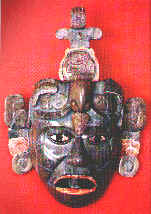|
|
Religion was of key importance in Maya culture, permeating all aspects of life. Priests had great influence among both the elite and ordinary people, since they directed ceremonies and rites to propitiate the supernatural, which was ruled by different gods.
Gods embodied natural forces, the celestial bodies, the rain that was so necessary for survival, and death.
Gods were worshiped with offerings, festivals, penitence and self-mutilation. Gods included:
Chaac, god of Rain and Lighting
Hunab Ku, Creator god
Hunab Ku, lord of the god of Wind
Hunab Ku, goddess of Moon and Childbirth
Hunab Ku, god of Wind
Ek Chuak, patron of cacao and god of War
Ah Puch, god of Death, who was also known as Yum Kimil or Kisin.
Later, during the era of Toltec influence from the Central Plateau, the god Quetzalcoatl, the feathered serpent, was worshiped, who was given the name of Kukulcan in Maya.
Gods were also symbolized by animals; for example, rain as snake, sun as jaguar or macaw, and death by owl or bat. Thus, in carving paintings and monuments, deities may be shown as fabulous beings that incorporate animal and human forms decorated with plant motifs or else with fangs, claws and feathers.
Mayas thought of the Universe as formed by three levels: Heaven, Earth and Underworld. Sky was divided into 13 planes, inhabited by celestial bodies, which were gods, and Itzamna, the supreme god, who gave life to all the cosmos.
They thought of Earth as flat plate floating on water, but also as enormous crocodile with vegetation on its back.
Underworld considered of 9 layers; the lowest being the realm of Ah Puch, god of death, who was usually represented as human skeleton.
Sky, Earth and Underworld were in turn each divided into 4 sectors, corresponding to cardinal points. Each of these had its own color value, and Ceiba (held to be scared tree) of the same color stood there. At the center stood the great mother Ceiba, the hub of the world.
They believed that gods have created and destroyed the universes several times. On each occasion, man had progressed in his evolution until he arrived at Maya era. Here, man had been made from corn dough and had the obligation to honor and feed gods with offerings and sacrifices, so that they in turn would ensure that the universe would continue to exist.

|
|

